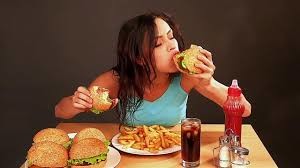 Have you ever noticed that most of the time you eat in response to an emotional trigger? When we are happy, sad, celebrating, depressed, angry, frustrated or scared we often reach for a candy bar or another type of comfort food. This is called emotional eating. And, unfortunately, it is also a type of eating that is very common to individuals who suffer from obesity or are even just a few pounds overweight.
Have you ever noticed that most of the time you eat in response to an emotional trigger? When we are happy, sad, celebrating, depressed, angry, frustrated or scared we often reach for a candy bar or another type of comfort food. This is called emotional eating. And, unfortunately, it is also a type of eating that is very common to individuals who suffer from obesity or are even just a few pounds overweight.
If you don’t recognize the symptoms you are in the majority of people who don’t understand the tie between emotional aspects of eating and impact on our habits. It isn’t unusual to not be aware of factors that impact whether or not we pick up a piece of food in response to an emotion. In fact, you may also not have known that most of our decisions have an emotional component which our body recognizes well before we have had the chance to make a rational decision.
Through years of subconscious conditioning by exposure to family, friends and advertising, we learn that foods are supposed to make us feel good. Although they fill a real biological need so that the body has energy to burn, we are instead using food to fill another void. We often use food to fill an emotional need that should be filled elsewhere
Interestingly, there is a fine line between emotional eating and a full-blown eating disorder. An individual who suffers from binge eating or compulsive eating goes beyond the basic behaviors of an emotional eater. So how can you tell the difference?
There are actually specific characteristics evident in people who have a full-blown eating disorder that are not evident in those who use food as an emotional crutch. A simplistic explanation is that individuals who regularly binge or eat large amounts of food rapidly, feel out of control about food, or feel they need to fast have a full-blown eating disorder
 Other behaviors that can distinguish a person is that the full-blown eating disorder individual will hide their food around the house or may actually eat while in hiding. For instance, the individual who is the primary shopper and the home maker will purchase foods that are hidden from the rest of the family and then eating after everyone else is gone to bed.
Other behaviors that can distinguish a person is that the full-blown eating disorder individual will hide their food around the house or may actually eat while in hiding. For instance, the individual who is the primary shopper and the home maker will purchase foods that are hidden from the rest of the family and then eating after everyone else is gone to bed.
There are people who have both an eating disorder and who are avid emotional eaters. Unfortunately, these people sometimes experienced dramatic events in their lives, either physical or sexual abuse, which leads to an eating disorder. The percentage of people who have an eating disorder who have experienced this type of abuse is higher than those with a simple emotional eating problem.
While people who have a significant emotional eating habit are not in medical or psychological danger, they do not suffer any less. Controlling eating habits starts with self-awareness of the problem and then leads to self-management. Self-awareness is the most difficult part since it involves the acceptance that you have a weakness that is what caused the problem of being overweight or obesity and you weren’t just “born” with it.
If you believe you might have a problem with emotional eating you can begin by keeping a short four to five day diary. Write down each time that you eat, and not only what you eat at the time of day you eat, and how you’re feeling each time you reach for another morsel of food. You first must acknowledge that there will be a feeling there for you to discover what that feeling is. Through acknowledgment, self discovery and persistence, identifying those emotions will become easier each day.
At the end of the fifth day you can look through the diary and note how many times you ate because you were, or thought you were, hungry. Evaluate the number of times you ate and then times of the day as well as other emotions that seemed to be involved in the automatic reach for food. Be extremely honest because you are not hurting or helping anyone else but yourself.
 The next step is self-management. Like all other things in life, the longer you do something the easier it gets. Practice really does make perfect. You may choose to do this part on your own but you will have more success if you enlist the help of a partner, or at least a calendar.
The next step is self-management. Like all other things in life, the longer you do something the easier it gets. Practice really does make perfect. You may choose to do this part on your own but you will have more success if you enlist the help of a partner, or at least a calendar.
Continue to write down the times that you eat and your emotional reasons why. As you are forced to write, before you eat, and read your reasons, you will be encouraged to put that food down when you’re angry, depressed or on an emotional high. The act of emotional eating will decrease and you’ll be surprised to once again feel feelings about actual hunger!
Resources:
KidsHealth.org: Emotional Eating
http://kidshealth.org/teen/your_mind/emotions/emotional_eating.html
Eating Disorders: Psychological Determinants of Emotional Eating in Adolescents
http://www.ncbi.nlm.nih.gov/pmc/articles/PMC2859040/
Temple University: Study Identifies Triggers for Emotional Eating
http://news.temple.edu/news/study-identifies-triggers-emotional-eating
MayoClinic.com: Weight Loss Help: Gain Control of Emotional Eating


Leave a Reply